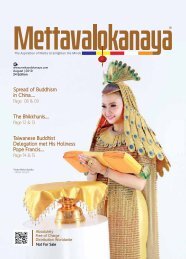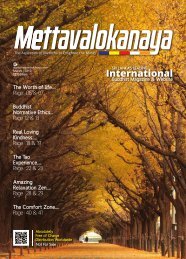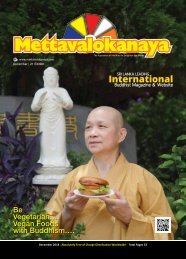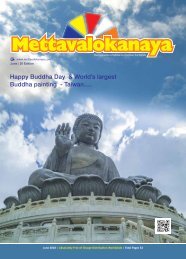#Mettavalokanaya_International_Buddhist_Magazine_May_2021
This is the World’s Most Popular & Leading Monthly International Buddhist Magazine, “Mettavalokanaya” on May 2021 Vesak Edition - 31. https://mettavalokanaya.com/magazine-31/ http://www.mettavalokanaya.com/
This is the World’s Most Popular & Leading Monthly International Buddhist Magazine, “Mettavalokanaya” on May 2021 Vesak Edition - 31.
https://mettavalokanaya.com/magazine-31/
http://www.mettavalokanaya.com/
Create successful ePaper yourself
Turn your PDF publications into a flip-book with our unique Google optimized e-Paper software.
Nature of
Happiness….
Human beings can experience
two kinds of happiness:
that which is dependent
upon an external stimulus
and that which is not. The first kind
of happiness is experienced at its
most basic level in sensual pleasure:
seeing, hearing, smelling, tasting
and touching agreeable things. It
also includes the positive emotions
we experience through personal
relationships, worldly accomplishment
and social status. The second kind of
happiness is known through spiritual
development. It is first enjoyed
through the cultivation of generosity
and moral discipline, but reaches
its most profound levels through
meditation. Seasoned meditators
recognize the zest and bliss that arise
in a focused mind as unquestionably
superior to pleasures dependent upon
the grosser senses.
But refined meditative states do
not constitute the highest happiness.
It is in the gradual abandonment of
toxic mental states—the root cause
of suffering—that the practitioner
discovers a stable and sublime sense
of well-being. This is considered as
a higher kind of happiness which is
experienced as a natural expression
of the cultivated mind, rather than
as a transient experience subject
to gain and loss. Lay Buddhists are
encouraged to pursue, in moderation,
worldly happiness compatible with
access to inner happiness; and to
relinquish indulgence in worldly
pleasures that turn the mind away
from spiritual cultivation.
Why do so few people seem
truly happy? - The Buddha taught
that all living beings are born with an
instinctive wish to avoid suffering and
to experience happiness. The problem
is that lacking wisdom, we both
continually act in ways that create
the conditions for suffering, and also
neglect acting in ways that create
the conditions for happiness. We seek
happiness in things that inevitably
disappoint us; we avoid things that
would lead to our long-term welfare.
In short, we are our own worst enemy.
Few people have seriously considered
the nature of happiness. Of those who
have, even fewer commit themselves
to systematically eradicating its
inner obstacles and cultivating
its supporting conditions. It is not
surprising that so few people are truly
happy. One of the basic premises of
Buddhism is that the more clearly we
see the nature of things, the less we
suffer, and the happier we become.
Indeed, the Buddha referred to
Nibbāna, the goal of Buddhist practice,
as ‘the supreme happiness’. Worldly
happiness is fleeting and unreliable.
The happiness of a cultivated mind is
a lasting refuge.
But isn’t Buddhism all about
suffering? - The Buddha said that
all of his teachings, traditionally
numbered as 84,000, could be
reduced to just two: dukkha and
the end of dukkha. Suffering, in its
sense of physical or mental distress,
is only the coarsest expression of
dukkha. The relationship between
the English word “suffering” and the
Pāli concept of dukkha is comparable
to that between bright red and color.
Dukkha could also be translated as
a chronic sense of lack, or a flaw or
incompleteness of experience. In this
sense, dukkha is experience seen as
“not-Nibbāna”. For this reason, the
most subtle and sublime mental
states are still considered to lie
within the realm of dukkha, because
as they are conditioned phenomena,
attachment to them cannot provide
lasting peace. Put most simply,
dukkha might be expressed as “a
lack of true happiness”. The Buddha
taught the path towards the cessation
of suffering, but emphasized that
freedom from suffering was only
possible by facing up to it and fully
comprehending its nature. In the First
Noble Truth, the Buddha says that the
life of the ordinary unenlightened
being is characterized by dukkha
due to the cravings that accompany
ignorance of the way things are.
Is it correct that Buddhism
teaches us to give up all desires? -
Buddhism distinguishes two kinds
of desire: the first (tanhā) to be
abandoned and the second (chanda) to
be cultivated. Tanhā is the desire that
arises from a basic misunderstanding
of the way things are: perceiving
permanence, happiness and selfhood
where they do not exist. Desire for the
pleasures to be had through getting,
getting rid of and becoming is tanhā.
Tanhā leads to personal suffering and
is the basis of almost all social ills.
Chanda is the desire that arises
from a correct understanding of the
way things are. At its heart lies the
aspiration for truth and goodness.
Desire to do well, desire to act well,
desire to act kindly, desire to act
wisely—all desires based on an
aspiration for the true and good lead
to personal fulfillment and healthy
communities. The distinction between
chanda and tanhā is not philosophical
but psychological. By looking closely
at the raw experience of life the
distinction between desires that lead
to genuine happiness and those that
do not becomes increasingly clear.
What does it mean to “let go”? -
The Buddha taught us to observe how
we constantly create suffering for
ourselves by grasping onto the body
and its senses, feelings, perceptions,
thoughts, emotions as being “me” or
“mine”. Learning how to abandon that
habit is learning how to “let go”. It is
not possible through an act of will.
Letting go occurs naturally when
the trained mind is keen enough to
perceive that there is nothing to be
found in our direct experience which
Most Venerable Ajahn
Jayasaro Maha Thera
Janamāra Hermitage,
Foot of Khao Yai Mountain
National Park, Nakhon
Ratchasima,
Thailand.
“Cultivated
Mind”
corresponds to the concept of “me”
and “mine”.
“Me” and “mine” are not, however,
mere illusions; they are extremely
useful social conventions, and the
Buddha taught that they should be
respected as such. Although the body,
for example, is strictly speaking “not
mine”, that does not mean that it
should be neglected. Letting go of
the body does not mean giving up on
exercise, bathing and a healthy diet.
It means not allowing one’s life to be
defined in terms of the body. It means
freeing oneself from all the anxiety,
insecurity and vanity, and all the fear
of aging, sickness and death that
accompanies an unwise relationship to
the body. “Letting go” is also an idiom
used for intelligent effort. Knowing
that no effort we make exists in a
vacuum, that it will always be affected
to some degree by conditions over
which we have no control, we let go
of our demands and expectations for
the future. We create the best possible
conditions for reaching our goals, and
then let go of the results.
20 l Mettavalokanaya l May l 2021 2021 l May l Mettavalokanaya l 21
















